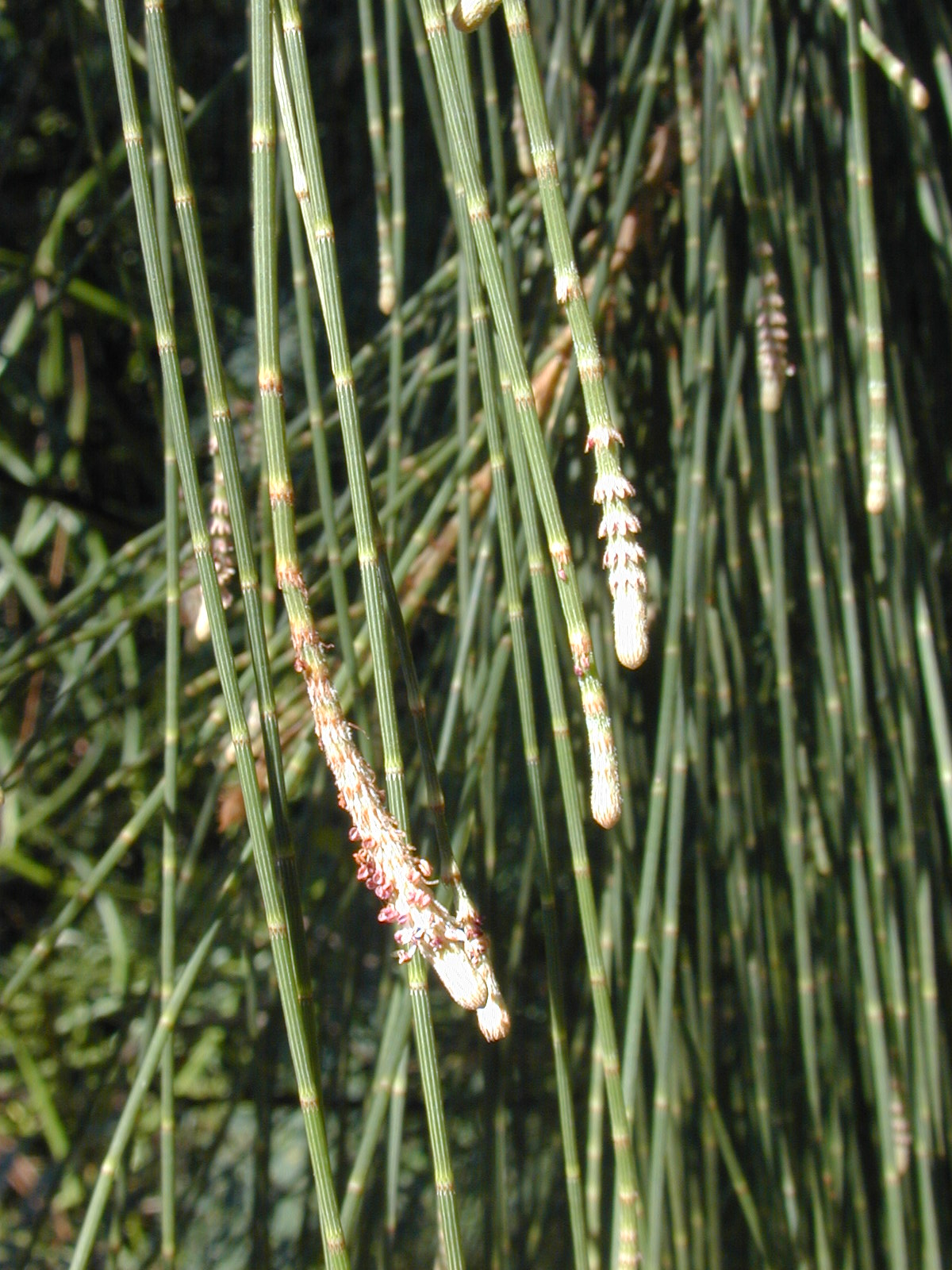- Casuarina
Taxobox
name = "Casuarina"

image_width = 240px
image_caption = "Casuarina equisetifolia" stems and leaves
regnum =Plant ae
divisio = Magnoliophyta
classis =Magnoliopsida
ordo =Fagales
familia =Casuarinaceae
genus = "Casuarina"
genus_authority = L.
subdivision_ranks = Selected species
subdivision = See text"Casuarina" is a
genus of 17 species in the familyCasuarinaceae , native toAustralasia , southeasternAsia , and islands of the westernPacific Ocean . It was once treated as the sole genus in the family, but has been split into three genera (seeCasuarinaceae ).Flora of Australia: [http://www.anbg.gov.au/abrs/online-resources/flora/stddisplay.xsql?sn_infspnm=CASUARINA&sn_infsprnk=gen.&sn_fam=casuarinaceae&sn_gen=&sn_sp= "Casuarina"] ] Australian Plant Names Index: [http://www.anbg.gov.au/cgi-bin/apni?taxon_name=Casuarina%25 "Casuarina"] ]They are
evergreen shrub s andtree s growing to 35 m tall. The foliage consists of slender, much-branched green to grey-green twigs bearing minute scale-leaves in whorls of 5–20. Theflower s are produced in smallcatkin -likeinflorescences ; the male flowers in simple spikes, the female flowers on short peduncles. Most species are dioecious, but a few are monoecious. Thefruit is a woody, oval structure superficially resembling aconifer cone made up of numerous carpels each containing a single seed with a small wing.Huxley, A., ed. (1992). "New RHS Dictionary of Gardening". Macmillan ISBN 0-333-47494-5.]"Casuarina" species are a food source of the
larva e of hepialidmoth s; members of the genus "Aenetus ", including "A. lewinii" and "A. splendens", burrow horizontally into the trunk then vertically down. "Endoclita malabaricus" also feeds on "Casuarina". The noctuidTurnip Moth is also recorded feeding on "Casuarina".elected species
*"
Casuarina cristata " Miq. Northeastern Australia (Queensland, New South Wales).
*"Casuarina cunninghamiana " Miq. Northern and eastern Australia (Northern Territories to New South Wales).
*"Casuarina equisetifolia " L. Northern Australia, southeastern Asia, (Madagascar, doubtfully native).
*"Casuarina glauca " Sieber ex Spreng. New South Wales.
*"Casuarina grandis " L.A.S.Johnson. New Guinea.
*"Casuarina junghuhniana " Miq. Indonesia.
*"Casuarina obesa " Miq. Southern Australia (southwestern Western Australia, New South Wales [one site, now extinct] , Victoria).
*"Casuarina oligodon " L.A.S.Johnson. New Guinea.
*"Casuarina pauper " F.Muell. ex L.A.S.Johnson. Interior Australia.Sources:Germplasm Resources Information Network: [http://www.ars-grin.gov/cgi-bin/npgs/html/splist.pl?2164 "Casuarina"] ]Cultivation
Commonly known as the she-oak, sheoak, ironwood, or beefwood, casuarinas are commonly grown in tropical and subtropical areas throughout the world. The tree has delicate, slender ultimate branches and leaves that are no more than scales, making the tree look more like a wispy
conifer . The plants are very tolerant of windswept locations, and are widely planted as wind-breaks, although usually not in agricultural situations."C. equisetifolia" is a common tropical seashore tree known as Common Ironwood, Beefwood, Bull-oak, or Whistling-pine and is often planted as a windbreak. The wood of this tree is used for shingles, fencing, and is said to make excellent, hot burning firewood.
"C. oligodon" has been planted in New Guinea in an ancient (more than 3,000 years)
silviculture by highland gardeners practicing an intensive traditionalpermaculture . The wood of this tree is used for building-timber, furniture and tools and makes excellent firewood. The tree's root nodules are known to fix nitrogen, and it is traditionally prized for its ability to increase the soil's fertility. Its abundant leaf-fall is high in nitrogen and traditionally prized for mulch.The gum exuded from some "casuarinas" is edible and was a food source for Aboriginal people.
As invasive plants
"C. cunninghamiana" and "C. equisetifolia" have been introduced species in several countries, including
Argentina , China,Egypt ,Israel ,Iraq ,Kenya ,Mexico ,South Africa ,Bahamas [http://www.best.bs/Documents/bahamas_nationalstrategy.doc] and the southernUnited States ; in the United States it was introduced in the early 1900s, and is now considered aninvasive species .USFS FEIS: [http://www.fs.fed.us/database/feis/plants/tree/casspp/all.html "Casuarina"] ] USDA Forest service: [http://www.na.fs.fed.us/pubs/silvics_manual/volume_2/casuarina/casaurina.htm "Casuarina"] ] The species has nearly quadrupled in southern Florida between 1993 and 2005. [IFAS: [http://biscuitgis.com/srfer/ SRFer Mapserver] ]"C. equisetifolia" is widespread in the
Hawaiian Islands where it is growing both on the seashore in dry, salty, calcareous soils and up in the mountains in high rainfall areas on volcanic soils. It is also an introduced, invasive plant inBermuda . It was introduced to replace the "Juniperus bermudiana " windbreaks killed by juniper blight in the 1940s. Now they are growing on cliffs and sandy slopes strangling all surrounding plants, or covering them in needles, they also erode the cliffs by digging their roots deep into them and splitting them apart. The plants are strongly suspected of having allelopathic properties, as evidenced by the near absence of understory once a mat of litter develops around the plants.References
Gallery
Wikimedia Foundation. 2010.
